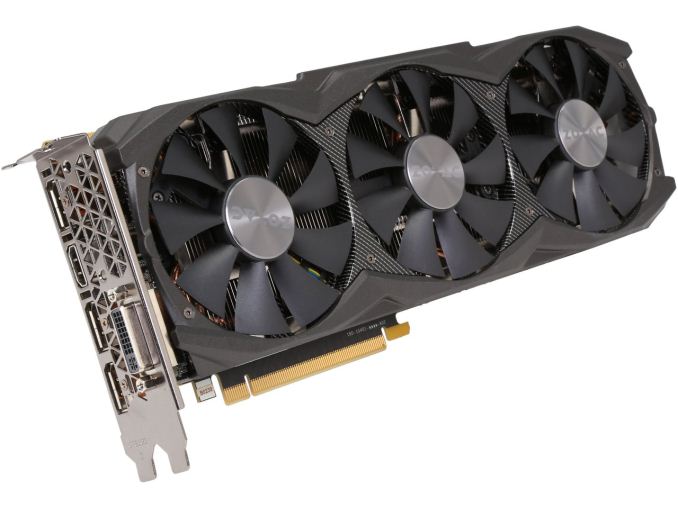Build-A-Rig Round 1: The $1500 PCs and Interviews from Corsair and Zotac
by Ian Cutress on July 8, 2015 5:15 PM EST- Posted in
- Build-A-Rig
- Corsair
- ZOTAC
- Interview

Build-A-Rig Round 1 - $1500 Single Monitor Gaming PC
Last week we introduced our new Build-A-Rig project. At a high level, we ask two or three companies in the PC industry each round to configure a system to a budget. Then, with our partners Newegg, we build and test each system in glorious battle, along with interviewing the participants about how they approach the industry. Regardless of the winner, all the systems built are given away to our lucky readers. Imagine Top Gear UK’s ‘Star In A Reasonably Priced Car’, but instead of celebrities racing around a track, we let the configured PCs do the racing where both style and performance count. In this first round, we chose Corsair Memory and Zotac as the first head-to-head.
The Rules
When we approach the companies to configure within a budget, there are certain rules they have to follow in order to be fair:
- All components must be available at Newegg.com at the time of selection (so no pre-choosing unreleased parts)
- No combo deals will be considered
- No mail-in-rebates will be considered
- Components must be compatible
- There will be sometime between configuration and giveaway, so a 3% leeway is given on the overall build budget if prices change
- There is no compulsion to use the hardware of who you’re up against
- Each round, we will let the companies competing know who they’re up against, but not the build until it is published on AnandTech
- Each company must agree to an interview on their build
This means that whatever the budget, each participant might end up deciding a different sized build, or a different concept (Steam box or hardcore gaming). As we have found out, it also means that each participant has a stringent choice – either select their best components and perhaps have to reduce the rest of the build to fit the budget, or choose the best performance and only their own mid-or-low range hardware.
Of course, for each build by the companies that actually make the hardware, we also want our readers to chime in with their own thoughts. What would you do differently?
It should be noted that for Round 1, companies were asked to supply builds before June 10th, which is before the release of AMD’s Fury X.
The Contest
As this is Round 1 of our glorious project, we went straight in at a potential premium and asked our contestants to produce a specification list for a system that costs $1500, with a focus on single monitor gaming. For the parts list, this means the following:
- Processor (CPU)
- Motherboard
- Graphics Card(s) (GPU)
- Memory (DRAM)
- Storage (SSD or HDD, or both)
- Power Supply (PSU)
- Chassis (Case)
- CPU Cooling
- Operating System
- Extras
Obviously there are more elements to a full gaming system than this, particularly when discussing the monitor, keyboard, mouse, mouse mat and other utilities, although we will reserve the choice of some of those with a bigger budget to play with. Something like a monitor is arguably a 10-year lifecycle purchase, whereas keyboards and/or mice are either upgrades from something very simple or replacements when breaks occur.
Because we only specified $1500 for single monitor gaming, this opens up how both Corsair and Zotac have interpreted what this means and we get very different builds focusing on performance and style.
The Participants – Dustin Sklavos from Corsair Memory
Long time readers from AnandTech will recognize the name Dustin Sklavos. Dustin is a former AnandTech editor, and was our primary cases, cooling and power supplies reviewer from 2010 until 2013. Dustin had an uncanny ability to go through reviews at an alarming rate, and was not afraid to show his feelings about a product. Corsair poached him in the latter half of 2013 and ever since he has been part of their technical marketing division, finding ways in which Corsair products are useful to end-users and writing parts of Corsair’s blog, but also getting stuck in with product design and currently stands as the product manager for Corsair’s latest 4K mini-ITX gaming project, the Bulldog.
The Participants – Chinny Chuang and Buu Ly from Zotac
Chinny and I (Ian) met over five years ago while Chinny worked with Rosewill, Newegg’s house brand. At the time she was technically Dustin’s primary contact for supplying cases for review. But we met at a trade show and share a common love of felines. Chinny has now been at Zotac for almost two years, devising strategies to aid Zotac’s position in the North America market, particularly with mini-PCs (which is Ganesh’s domain) and graphics cards. Chinny is joined on this build and in the Interview by Buu Ly, a longtime colleague of Chinny and they always seem to end up at the same companies working together.












117 Comments
View All Comments
etamin - Wednesday, July 8, 2015 - link
sorry for the typos, I didn't proofread.Dustin Sklavos - Wednesday, July 8, 2015 - link
The CS power supply is actually pretty beastly. My department keeps track of user feedback on major vendor sites, reporting when people have problems, and it's *extremely* rare to hear someone having an issue with a CS.The CPU cooler, I'll grant something else might've been a bit quieter. But - and this ties into the motherboard decision - the i5-4690K just isn't a hot, power-hungry chip. The only time heat becomes an issue on that processor is when you're pushing the voltage higher than is safe for the chip in the first place. By the same token, the motherboard has passive cooling on the power delivery, and most boards are grossly overspecced on that front anyhow. The FIVR in Haswell and the clean power from the CSM both heavily mitigate the need for boatloads of high end power delivery on the board. I'd trust it.
That said, I've also internally tested our liquid coolers against competing high end air coolers, and the H80i GT's cooling perf basically starts where air coolers stop. And if I can cool a Titan X with an H55 (and I can, and I have), the comparatively inexpensive H60 is the right choice for the CPU cooler.
Also, I do agree with Chinny and Buu's tack towards aesthetics, which I deprecated in favor of raw performance. I'm happy that the two systems aren't really directly comparable, that they both take different routes to get to the same destination.
etamin - Thursday, July 9, 2015 - link
You're right that the 4670k is a "relatively not hot/power-hungry chip." But the question then becomes, how much OC can you get out of it on that particular board. I'm guessing we'll see with the upcoming review, but I'm more concerned about long term power quality and stability supplied by that board. Unfortunately, the OC longevity can't be proven by anyone, and that's why I would be hesitant to be the guinea pig.I must admit I have not used any AIOs since the original H80/H70 since the Noctua NH-D14 prices have been very attractive for a while now. Another reason I am averse to AIOs is the radiator is they are difficult to clean when clogged with dust (again, attention to case filters and long term maintenance), and they dont free up as easily when blown out with air.
The CS power supplies do have many positive user reviews. But please please keep in mind that Corsair is among the most, if not THE most, hyped component/peripheral brands out there. I'm sure you're aware of this. This is made possible by Corsair covering more component/peripheral markets than anyone else, expanding when a successful product gains a foothold in each segment. Many first time builders choose Corsair because of forum advice given out by other inexperienced builders who have tried nothing but Corsair, and the snowball effect continues.
No offense to Corsair as I do like some of their products as mentioned earlier, but I would think that much of the positive feedback is made by fanboys. The CS PSUs as a series is rated rather average across the PSU review sites I trust, and to me, the 3 year warranty is confirmation of that. For a 980 Ti, I think a step up is justified.
etamin - Thursday, July 9, 2015 - link
Sorry Dustin I don't mean to come off as abrasive toward you or your company. You are certainly more knowledgeable than I ever will be when it comes to computers (my work has nothing to do with computers although I have often thought about case and peripheral design for the fun of it).I wanted to add that I really did enjoy the article, I think it's a breath of fresh air for AT in a long while. The interviews made the builds a lot more interesting and relevant to those of us without an immediate need for a new system. It reminds me of the days when I read MaximumPC (the physical magazine) before I even knew the difference between memory and storage hehe
Dustin Sklavos - Thursday, July 9, 2015 - link
You didn't come off as abrasive and your perceptions are valid.I'd like to think we've earned the fans we have, but I'm keen to point out that people are a bit more likely to leave a negative review than a positive one, especially when it comes to PSUs, which aren't especially sexy products. We sell an absolute mountain of power supplies, more than coolers or cases, but the cases and coolers will often get more reviews because there's more to discuss. A PSU, by and large works or doesn't. So I do see what you're saying.
The 3-year warranty is a totally fair complaint.
I appreciate the respectful engagement. I continually worry about coming off like a PRobot and mentioned that as much to Ian, but the honest truth is the guys designing this stuff are eating their own dog food. I see how the sausage is made and by and large it's pretty good sausage.
BuuLy - Wednesday, July 8, 2015 - link
Hi Dustin! Chinny! and all the commenters. This article is pretty active and that's really awesome because we had some fun putting it together. Both builds are great and I'd take and use any of them any day. Even better that even some of you are even taking the challenge to configuring your own build.DPUser - Wednesday, July 8, 2015 - link
Love the sprit and camaraderie exhibited here… thanks Dustin and Chinny!TheHolyLancer - Thursday, July 9, 2015 - link
I actually built something similar for my friend.http://pcpartpicker.com/p/jGCgjX
Namely, he does not OC that much, so the basic one where we can play with bclk or leaving it stock is fine.
Then picked an evga 980 ti ACX 2.0 superclock, again not so much OCer, but with just the basic cooling from acx 2.0 it is rock solid and can hit 1500 core if he is lucky.
Cheapest memory, case, mobo that had some features and mixed storage of SSD + hdd.
Then I made sure to pick a nice 80+ plat 650W psu to power this relatively hungry setup.
chlamchowder - Thursday, July 9, 2015 - link
I like Dustin's build, except for only having a 240 GB SSD. Game installs take ridiculous amounts of space. Zotac's 500 GB drive is a lot better in that respect. It'd be painful, but I'd drop down from the i5-4960k + H60 to an i5-4460 + stock cooler and give up overclocking for a bigger SSD.I also question the value of using DDR3-1866 vs DDR3-1600 in both builds.
zodiacfml - Thursday, July 9, 2015 - link
Nice addition to Anandtech. While this is the first episode, I would like to suggest things.Since there would be too many options and intentions, it seems better if we could specify the requirements so that contestants will have some direction. To iterate, when we build something for a user, we ask for the usage and desires together with the budget.
Will it be for gaming, workstation, or both? HTPC? Servers? Virtual Machines? Huge storage? Which applications and games?
Additionally, I believe that resolution and refresh rates should be set, RAM and storage size. In gaming, specify which games and image quality settings are compulsory for the build. It is up to the contestant to research and test the build for these games depending on their priorities.